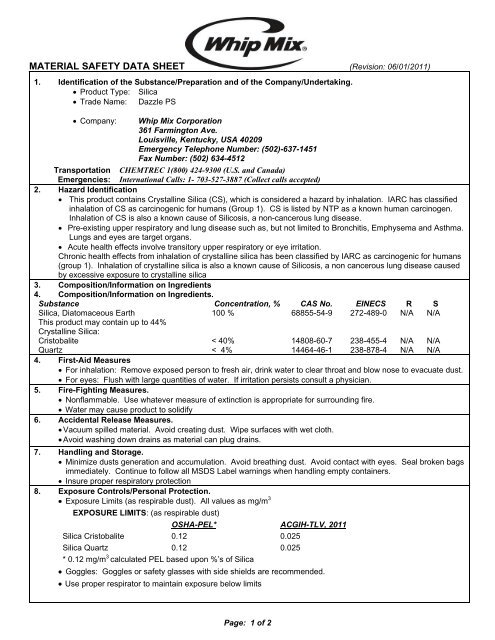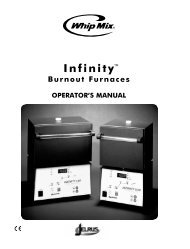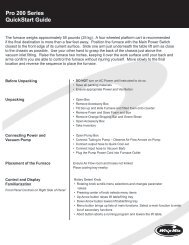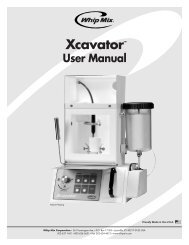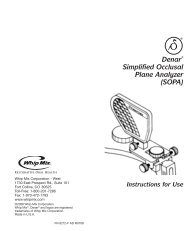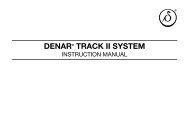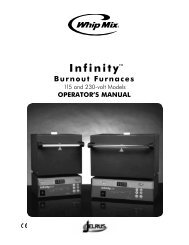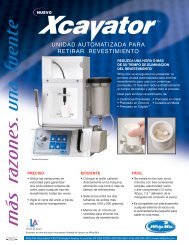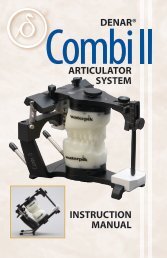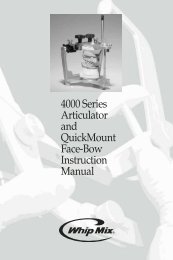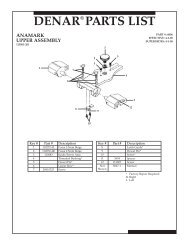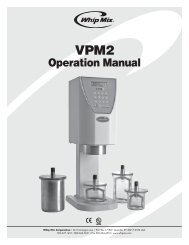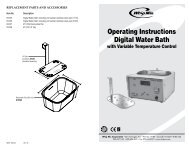Dazzel PS MSDS - Whip Mix
Dazzel PS MSDS - Whip Mix
Dazzel PS MSDS - Whip Mix
- No tags were found...
Create successful ePaper yourself
Turn your PDF publications into a flip-book with our unique Google optimized e-Paper software.
MATERIAL SAFETY DATA SHEET (Revision: 06/01/2011)1. Identification of the Substance/Preparation and of the Company/Undertaking.• Product Type: Silica• Trade Name: Dazzle <strong>PS</strong>• Company: <strong>Whip</strong> <strong>Mix</strong> Corporation361 Farmington Ave.Louisville, Kentucky, USA 40209Emergency Telephone Number: (502)-637-1451Fax Number: (502) 634-4512TransportationEmergencies:CHEMTREC 1(800) 424-9300 (U.S. and Canada)International Calls: 1- 703-527-3887 (Collect calls accepted)2. Hazard Identification• This product contains Crystalline Silica (CS), which is considered a hazard by inhalation. IARC has classifiedinhalation of CS as carcinogenic for humans (Group 1). CS is listed by NTP as a known human carcinogen.Inhalation of CS is also a known cause of Silicosis, a non-cancerous lung disease.• Pre-existing upper respiratory and lung disease such as, but not limited to Bronchitis, Emphysema and Asthma.Lungs and eyes are target organs.• Acute health effects involve transitory upper respiratory or eye irritation.Chronic health effects from inhalation of crystalline silica has been classified by IARC as carcinogenic for humans(group 1). Inhalation of crystalline silica is also a known cause of Silicosis, a non cancerous lung disease causedby excessive exposure to crystalline silica3. Composition/Information on Ingredients4. Composition/Information on Ingredients.Substance Concentration, % CAS No. EINECS R SSilica, Diatomaceous Earth100 % 68855-54-9 272-489-0 N/A N/AThis product may contain up to 44%Crystalline Silica:Cristobalite < 40% 14808-60-7 238-455-4 N/A N/AQuartz < 4% 14464-46-1 238-878-4 N/A N/A4. First-Aid Measures• For inhalation: Remove exposed person to fresh air, drink water to clear throat and blow nose to evacuate dust.• For eyes: Flush with large quantities of water. If irritation persists consult a physician.5. Fire-Fighting Measures.• Nonflammable. Use whatever measure of extinction is appropriate for surrounding fire.• Water may cause product to solidify6. Accidental Release Measures.• Vacuum spilled material. Avoid creating dust. Wipe surfaces with wet cloth.• Avoid washing down drains as material can plug drains.7. Handling and Storage.• Minimize dusts generation and accumulation. Avoid breathing dust. Avoid contact with eyes. Seal broken bagsimmediately. Continue to follow all <strong>MSDS</strong> Label warnings when handling empty containers.• Insure proper respiratory protection8. Exposure Controls/Personal Protection.• Exposure Limits (as respirable dust). All values as mg/m 3EXPOSURE LIMITS: (as respirable dust)OSHA-PEL* ACGIH-TLV, 2011Silica Cristobalite 0.12 0.025Silica Quartz 0.12 0.025* 0.12 mg/m 3 calculated PEL based upon %’s of Silica• Goggles: Goggles or safety glasses with side shields are recommended.• Use proper respirator to maintain exposure below limitsPage: 1 of 2
9. Physical and Chemical Properties• Fine white, odorless powderVapor pressure (mmHg)Not ApplicableVapor density (air=1)Not ApplicableEvaporation rateNot ApplicableBoiling point ºCNot ApplicableFreezing point ºCNot ApplicablepH9 – 10.5 (when mixed with water)Specific gravity (water=1): 2.3FlammabilityNot ApplicableFlash point ºCNot ApplicableMelting pointNot ApplicableWater SolubilityNegligible10. Stability and Reactivity• Basically stable, may solidify if contacted by water.• Incompatible with hydrofluoric acid.• No hazardous decomposition products.11. Toxicological Information• Route of entry: Inhalation.• Effects of acute exposure: None known.• Inhalation of excessive dust over a prolonged period can result in lung damage, Silicosis.• Carcinogenicity: The International Agency for Research on cancer (IARC) reports inhaled crystalline silica isa Group 1 carcinogen to humans. NTP has listed crystalline silica as carcinogen.• Synergistic products: Mycobacterium Tuberculosis.12. Ecological Data• No ecotoxicological studies are available. Generally considered chemically inert in the environment. Notdangerous to water.13. Disposal Considerations• Waste is not hazardous as defined by RCRA (40 CFR 261). Other state and local regulation may vary;consult local agencies as needed. Used material, which has become contaminated, may have significantlydifferent characteristics based on contaminates and should be evaluated accordingly.14. Transport Information• D.O.T. proper shipping name: Earth, Diatomaceous, Crude or Ground. Its hazard classification is notlisted.15. Regulatory Information• OSHA Hazard Communications Standard, 29 CFR 1910.1200: Contains material considered hazardous.• RCRA: This material is not defined as hazardous water, per 40 CFR 261.• TSCA: These products contain materials listed in the TSCA inventory and is not otherwise regulated byTSCA Sec. 4, 5, 6, 7 or 12.• CERCLA: Materials not reportable under CERCLA. Local requirements may vary• SARA: 311/312 hazard categories - immediate and delayed health, 313 reportable ingredients – none• California Proposition 65: Investments contain Crystalline Silica known to the state of California to causecancer.16. Other Information• HMIS Rating: Health 3 Flammability 0 Reactivity 0 Other 0Hazard: 4-Severe; 3-Serious; 2-Moderate; 1-Slight; 0-MinimumPrepared By: Donna Ringo, CIHTranslated By:Date: 6/13/2011CPL90530 i:\msds\silica.doc(rev.08/04/2008)Page: 2 of 2


